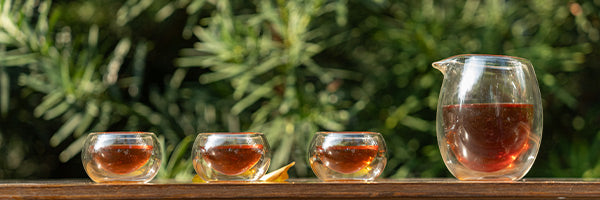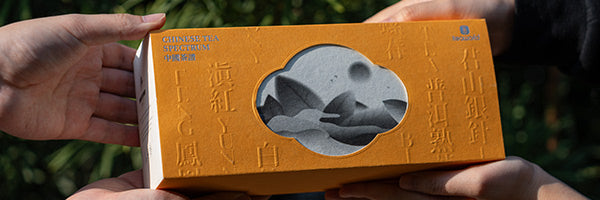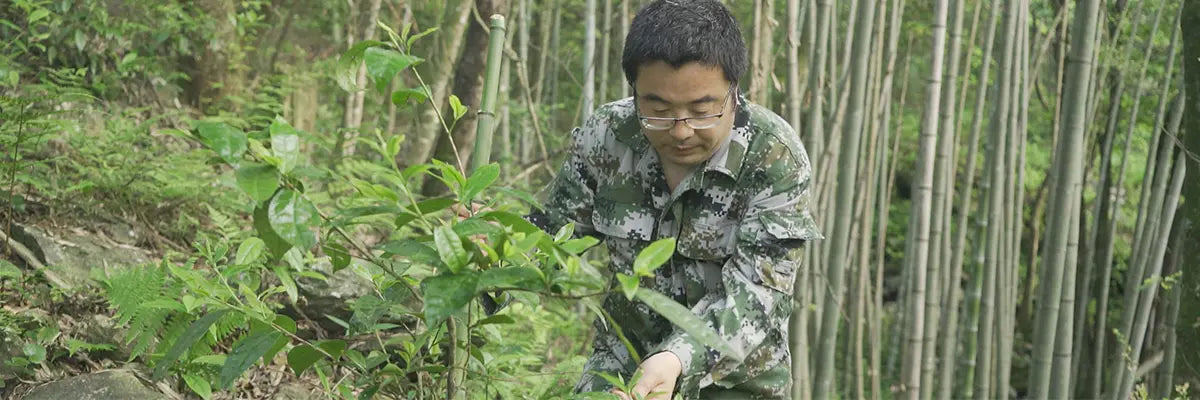Что такое Да Хун Пао?
Da Hong Pao — это известный листовой улун, который в основном производится в городе Уишань, провинция Фуцзянь, Китай. Это разновидность чая из скалы Уи, известная своим превосходным качеством и уникальным вкусом.
У чая Да Хун Пао долгая история, которая берет свое начало в период Хунву династии Мин. Когда-то он был данью династиям Мин и Цин.
Листья чая Дахонпао имеют плотно скрученный вид и свежий зеленовато-коричневый цвет. Заваренный чай имеет яркий оранжево-желтый цвет, а листья демонстрируют смесь красного и зеленого. Отличительной чертой Да Хун Пао является его аромат, особенно аромат орхидеи, известный как «каменное очарование», который не только интенсивный, но и продолжительный, что способствует высокой репутации Да Хун Пао. При выборе подарочных наборов китайского чая для семьи и друзей желательно выбрать тот, который включает высококачественный Да Хун Пао.
Историческая легенда о Да Хун Пао

Самая популярная легенда о Да Хун Пао относится к временам династии Мин.
В период Хунъу ученый, направлявшийся на императорский экзамен в Пекин, заболел, проходя через Уишань. Монах из соседнего храма Тяньсинь случайно проходил мимо, спас его и заварил ему чашку чая. После того, как он выпил его, боль в животе ученого немедленно прошла, и он выздоровел.
Успешно сдав императорский экзамен и став выдающимся ученым, он вернулся в Уишань. В благодарность за спасительную помощь монаха он накинул свой красный халат на чайное дерево. Поэтому чай получил название Да Хун Пао, что означает «Большой красный халат».
Превосходные условия выращивания Да Хун Пао

Основная зона производства Да Хун Пао находится в живописном районе Уишань. Да Хун Пао также называют чаем Уи Да Хун Пао. Выдающаяся среда выращивания является одной из причин, по которой Да Хун Пао считается одним из лучших листовых чаев .
Климат:
Климат в районе производства Да Хун Пао мягкий, с теплой зимой и прохладным летом. Среднегодовая температура колеблется от 18 до 18,5℃. В регионе выпадает много осадков, годовое количество составляет около 2000 мм.
Условия солнечного света:
Большинство чайных садов Да Хун Пао расположены среди скал и долин, окруженных горами, что обеспечивает естественный барьер. Воздействие солнечного света относительно короткое, и риск повреждения ветром минимален. Текущие источники и туманные облака обычны в горах и долинах, что способствует уникальному вкусу горного чая.
Почвенные условия:
Геологический состав Уишань принадлежит к меловой формации Уи. Нижняя часть состоит из кварцевого порфира, а средняя часть состоит из конгломерата, красного песчаника, сланца, туфового сланца и вулканической брекчии, образующих отдельные слои. Преобладающими материнскими породами в чайных садах Да Хун Пао являются вулканическая брекчия, красный песчаник и сланец. Подходящие почвенные условия способствуют превосходным внутренним качествам каменного чая.
Классификация регионов выращивания Да Хун Пао
Да Хун Пао можно разделить на чай Чжэнъянь, чай Баньян и чай Чжоу в зависимости от региона выращивания.

Чай Чжэнъянь:
Чай Чжэнъянь, выращенный в живописном районе Уишань, включает в себя оригинальные материнские деревья Да Хун Пао, такие как Люкенг Да Хун Пао, Санкэн, Лянке, Лянцзянь и Нэйвайгуйдун.
Баньяновый чай:
Баньяновый чай — это сорт Да Хун Пао, который выращивают в широких масштабах за пределами живописной местности Уишань, но все еще в пределах региона Уишань.
Чай Чжоу:
Чай, выращиваемый на больших площадях за пределами Уишань и на прилегающих равнинах, относится к категории чая Чжоу.
Классификация Да Хун Пао
Да Хун Пао можно разделить на Да Хун Пао материнского дерева, Чистопородный Да Хун Пао и Коммерческий Да Хун Пао.
1. Материнское дерево Да Хун Пао
Mother Tree Da Hong Pao — самый примитивный тип, произрастающий на скалах Цзюлунке в живописном районе Уишань. Он производится из одного из шести чайных деревьев. С 2006 года эти шесть чайных деревьев перестали собирать, из-за чего Mother Tree Da Hong Pao недоступен на рынке.
2. Чистокровный Да Хун Пао.
Чистокровные чайные деревья Да Хун Пао выращиваются путем бесполого размножения, то есть черенкования определенной ветви материнского дерева Да Хун Пао.
Качество чистокровного Да Хун Пао похоже на Материнское Дерево Да Хун Пао, но его не собирают напрямую с материнского дерева. Чистокровный Да Хун Пао нечасто встречается на рынке, и одним из известных примеров является Qidan Da Hong Pao.
3.Коммерческий Да Хун Пао
Коммерческий Да Хун Пао, также известный как купажированный Да Хун Пао, представляет собой смесь двух или более сортов (например, Шуйсянь, Ругуй и т. д.) для достижения насыщенного аромата и вкуса.
Почему разные сорта Да Хун Пао имеют существенную разницу в цене?

Различные регионы посадки:
Уникальная географическая среда Уишань определяет качество чая. Премиальные горные районы, в частности Санькэн, Лянцзянь или другие особые регионы, в последние годы стали все более дефицитными ресурсами. Из-за высокого спроса и ограниченного производства цена чая в этих районах имеет тенденцию к росту.
Факторы обработки:
Листовой улун, в частности Да Хун Пао, имеет один из самых сложных методов обработки среди китайских листовых чаев . Некоторые высококачественные листовые улуны требуют ручной обработки для обеспечения их качества. С ростом стоимости рабочей силы цена чая Да Хун Пао также растет.
Подводя итог, можно сказать, что чаи Да Хун Пао с превосходными горными районами и передовыми методами обработки, естественно, имеют более высокую цену. С другой стороны, чаи Да Хун Пао с более низкой ценой могут не обладать этими качествами. Однако важно отметить, что более высокая цена не всегда означает лучшее качество. Лучший чай — это тот, который соответствует индивидуальным предпочтениям. Рекомендуется попробовать чайный дегустатор , чтобы найти настоящий чай Да Хун Пао, который вам подходит по вкусу.
Как заваривать Да Хун Пао для получения наилучшего вкуса?

При заваривании Да Хун Пао и других листовых улунских чаев предпочтительным методом является заваривание чая Гунфу. Следуя методу заваривания чая Гунфу и обращая внимание на следующие три момента, вы можете улучшить вкус заваренного Да Хун Пао:
1.Выберите подходящую посуду для чая
Для заваривания чая Да Хун Пао рекомендуется использовать чайники из исинской глины или белые фарфоровые гайвани. Белые фарфоровые гайвани отлично подходят для демонстрации аромата и вкуса чая, при этом они экономичны и являются предпочтительным выбором для заваривания чая.
2.Используйте качественную воду
Хороший чай требует хорошей воды для заваривания. Использование некачественной воды может значительно ухудшить вкус и аромат высококачественного чая.
Для заваривания Да Хун Пао лучшим выбором будет вода из горного источника. Если вода из горного источника недоступна, очищенная вода также является хорошим вариантом.
3.Контроль времени заваривания
Для первых трех заварок Да Хун Пао рекомендуется выдерживать время заваривания в пределах 15 секунд. Последующие заварки могут иметь немного большее время заваривания.
Найдите больше листового чая улун с помощью нашего пробника чая улун.>>>
Эффективность чая Да Хун Пао
Чай Да Хун Пао обладает многочисленными полезными свойствами для здоровья, включая антиоксидантное действие, улучшение пищеварения, снижение уровня липидов в крови, освежение ума, антибактериальные и бактериостатические эффекты, а также помощь в потере веса. Ниже приведены три основных преимущества Да Хун Пао:
1.Антиоксидант
Да Хун Пао богат катехинами и эпикатехинами, которые являются антиоксидантами. Эти вещества эффективно устраняют свободные радикалы в организме, замедляют старение клеток и снижают риск развития рака, сердечно-сосудистых заболеваний и других связанных с ними состояний.
2.Улучшение пищеварения
Да Хун Пао содержит большое количество катехинов и флавоноидов, которые стимулируют перистальтику желудочно-кишечного тракта, способствуют секреции пищеварительных соков, улучшают пищеварение и облегчают желудочно-кишечный дискомфорт, запоры и связанные с ними проблемы.
3.Снижение уровня липидов
Да Хун Пао регулирует липидный обмен веществ, снижая уровень общего холестерина и холестерина липопротеинов низкой плотности, одновременно повышая уровень холестерина липопротеинов высокой плотности. Это помогает защитить здоровье сердечно-сосудистой системы.
Как хранить чай Да Хун Пао?
Правильное хранение имеет решающее значение для чая Да Хун Пао. При правильном хранении, даже после многих лет вскрытия, Да Хун Пао может сохранить свой превосходный вкус и аромат.
Метод хранения в сухом ящике:
Использование сухой коробки для хранения эффективно, поскольку обеспечивает стабильные температурные условия и изолирует чайные листья от воздуха, предотвращая сырость или окисление. Если возможно, рекомендуется хранить Да Хун Пао в сухой коробке.
Метод хранения в железной банке:
Этот метод подразумевает использование двухкрышечной цветной эмалированной чайной банки, доступной на рынке. Перед хранением проверьте герметичность железной банки, а во время хранения убедитесь, что банка плотно закрыта, чтобы добиться идеальной сохранности.
Метод хранения в керамической банке:
Убедившись, что керамическая банка чистая, заверните чай Да Хун Пао в пергаментную бумагу и поместите в банку пакетик с известью. Плотно закройте банку ватой. Важно заменять известь каждые 1-2 месяца, чтобы поддерживать оптимальные условия хранения.












































































